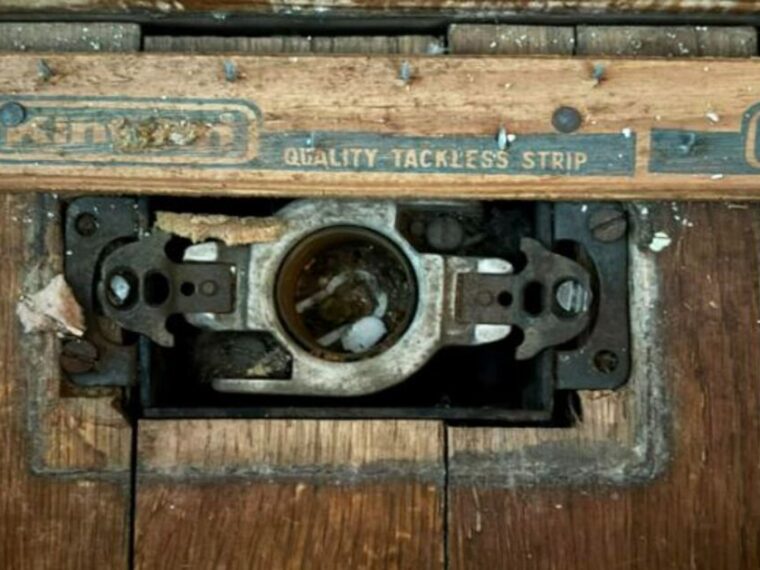Imagine this: You’re tearing up the carpet in your grandparents’ old house, and suddenly — bam — there it is. A light socket. In the floor. Not on the wall, not on the ceiling, but right there, embedded in the floorboards. Your immediate thought is probably, “Who in their right mind puts a light socket there?”
At first, it feels like a prank or an accident, but then you realize it’s something real — a relic from a fascinating chapter of electrical history. So let’s take a deep dive into this quirky piece of electrical design that once made perfect sense in its time.
The Flaky Early Days of Electricity: A Wiring Wild West
Electricity was the hot new thing in the late 1800s and early 1900s. Homes were transitioning from gas lighting to electric lighting, and this new technology was exciting but unregulated. The wiring and electrical systems we take for granted today were still being figured out — it was the Wild West of home electrification.
During this era, the Edison socket was the go-to device. Named after Thomas Edison, the Edison socket was a simple screw-in design made to hold incandescent light bulbs. But what many people don’t realize is that these sockets weren’t just used for lighting. Because electrical outlets as we know them today didn’t really exist, these sockets served double duty — they powered not only lamps but also small appliances like irons, fans, and radios by screwing in various adapters.
This meant that a single socket had to be versatile enough to power a range of devices, making it a kind of early multi-purpose power point.
Why Put a Socket in the Floor? The Logic Behind the Design
So why in the world would someone put an electrical socket in the floor? The answer boils down to practicality, aesthetics, and the challenges of early wiring.
Picture a large living room in a 1920s home with a big crystal chandelier hanging from the ceiling. Now imagine you want to place a lamp or an electric heater somewhere in the middle of the room — not near a wall. If you relied on wall outlets alone, you’d need to run long extension cords across the floor, creating an unsightly and hazardous tangle that could easily cause tripping or damage.
Enter the floor socket or floor box — an innovative, if somewhat quirky, solution. By embedding an electrical socket in the floor, homeowners could plug in lamps, heaters, or other devices right where they were needed, without trailing wires. The socket was flush or slightly recessed in the floor, often covered with a metal or Bakelite plate to protect it when not in use.
In other words, floor sockets helped keep wiring neat, minimized tripping hazards, and allowed more flexible room layouts.
The Downside: A Handy Asset or Dangerous Liability?
While the idea of a floor socket was clever, it came with some serious drawbacks, especially by today’s standards.
First off, having an open electrical socket on the floor poses obvious risks. Imagine spilled drinks, dust, or food crumbs getting into the socket — potential fire hazards. Foot traffic and wear and tear meant that these sockets were prone to damage. Metal covers could be bent or dislodged, and moisture was a constant threat.
Plus, early electrical standards were lax or non-existent. There were no ground fault interrupters (GFCIs), no tamper-resistant features, and the wiring insulation wasn’t as advanced as today. So floor sockets could be dangerous, especially in homes with kids or pets.
As electrical safety codes evolved, wall outlets with built-in safety features became the norm, and floor sockets began to fall out of favor. By the mid-20th century, floor sockets were largely seen as outdated or unsafe and were often removed during renovations.
A Personal Anecdote: When I Found One
This reminds me of a story from my own experience. I was helping a friend renovate an old farmhouse. While pulling up the worn linoleum in the living room, we spotted a small metal plate flush with the floor. Curious, we pried it open, revealing a floor socket — intact but clearly decades old.
We were baffled and amused, trying to imagine someone plugging in an iron or lamp right there, surrounded by heavy foot traffic. After a bit of research, we realized we were looking at a genuine artifact from a time when electricians and homeowners were inventing new ways to solve wiring challenges — sometimes with more imagination than foresight.
Modern Resurgence: The Floor Socket is Back — But Safer
Believe it or not, floor sockets have not disappeared completely. In fact, they’re experiencing something of a modern resurgence, especially in new homes with large open-concept floor plans.
Today, floor outlets are professionally installed with strict adherence to safety codes. They’re typically recessed into the floor, fitted with sturdy protective covers, and located in low-traffic areas where they won’t be stepped on or damaged.
These modern floor boxes are ideal for powering devices that naturally sit away from walls — think recliners with built-in USB chargers, floor lamps that define cozy reading nooks, or holiday decorations like Christmas trees.
Unlike their predecessors, today’s floor sockets often include grounding, weatherproofing, and tamper-resistant shutters — all designed to protect users and meet rigorous electrical codes.
Historical Context: Cooking With Gas, Lighting With Electricity
Finding a light socket in the floor is like discovering a time capsule from an era of rapid technological change. Around the turn of the 20th century, homes were just starting to embrace electricity while still relying on gas for cooking and heating.
Electric lighting replaced flickering gas lamps and candles, promising cleaner, safer, and more reliable illumination. But with electricity being so new, people experimented with all sorts of wiring methods.
Floor sockets are a testament to that era’s inventiveness — homeowners and electricians trying to bring electrical power to every corner of the house, even if it meant unconventional solutions.
Why This Matters to Homeowners and Renovators Today
If you’re renovating an old home and uncover a floor socket, it’s important to treat it with respect and caution. Here are some things to consider:
- Don’t use the old socket as-is. Electrical wiring from the early 1900s likely doesn’t meet modern safety standards. The socket and its wiring could be a shock or fire hazard.
- Consult a licensed electrician. Have the wiring inspected and replaced if necessary. Modern floor boxes can be installed safely and discreetly.
- Keep it as a conversation piece. Even if you replace or disable the old socket, preserving the original cover or documenting its history can be a cool nod to the home’s heritage.
Fun Fact: Edison’s Influence on Household Electricity
Thomas Edison’s name is forever tied to the development of household electric lighting, and the “Edison socket” design is one of his lasting legacies. This simple screw-in socket design was revolutionary at the time, replacing complicated and often dangerous lamp connectors.
Although the sockets themselves evolved, the basic idea remains in use today — your standard light bulb still screws into an Edison base. Floor sockets using these same bases were just an extension of the design’s flexibility.
The Future of Floor Sockets
With smart homes and wireless technologies advancing rapidly, the need for traditional floor sockets might decline in the coming decades. Wireless charging pads embedded in furniture or floors could replace physical outlets altogether.
However, for the foreseeable future, floor sockets will continue to play a practical role in lighting and powering devices in open spaces, with safety and aesthetics guiding their design.
Final Thoughts: Appreciating the Ingenuity (and Foolhardiness) of Our Predecessors
So next time you tear up old carpet or flooring and spot a socket in the floor, don’t immediately dismiss it as a mistake or a hazard — it’s a fascinating reminder of a pioneering time in home electrification.
It shows us just how far we’ve come in electrical safety and design, and offers a glimpse into the creative (if sometimes questionable) solutions homeowners and electricians dreamed up before standards were firmly in place.
Whether you choose to preserve it, replace it, or simply admire it from afar, a floor socket is a quirky piece of history — a conversation starter, a challenge, and a testament to human ingenuity.





